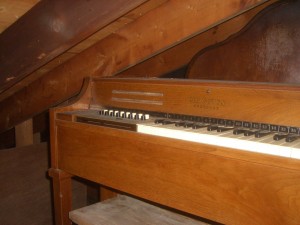One of the best parts of working with others interested in electronics is having similar hobbies: namely, electronics and music. And even though I have similar hobbies, I never really brought them up in conversation with co-workers (believe me, some of the stuff I have done pales in comparison to some of the people I work with). However, in the past few weeks it has really paid off talking about my non-work work, both for my personal hobbies and for things to write about that interest me.
Tektronics 425M Oscilloscope:
A few months back I had mentioned how I blew up my Wurlitzer 200 and needed to start troubleshooting it for possible problems. I also lamented the fact that I didn’t have a scope to look at waveforms when I finally got the DC characteristic where I want them. Fast forward to a few weeks ago and a friend and co-worker mentions that he had a scope that he had purchased on eBay but was DOA. Apparently it broke in the midst of shipping and he didn’t get charged by the seller. He also bought a working scope later and intended to fix this one, but never got to it. As such he was clearing out room and offered it to me, a truly generous offer.
The scope itself is a dual channel, 100 MHz scope. It is a military version of the scope so it possibly has better spec’d parts (but I haven’t looked into this too much).The main problem is that the beam does not render any images onto the phosphorescent screen. Other than that, it is supposed to work fine. Time will tell on the other components.
The interesting thing about the older analog scopes is that many of them can be repaired by non-professionals. More accurately, they can be repaired by individuals not employed by Tektronics because the schematics are available, the components are large enough to replace quasi-easily and there aren’t proprietary ASICs you have to order from the OEM. One notable fixer-upper of all old things Tektronics is Jim Williams, applications engineer for Linear Technologies and electonics writer (my favorite thing about him is that he lists his 84 Tek scopes at home when he writes his own bios at the end of books or articles). All of these things lead to some analog engineers being die-hard fans of analog scopes. They also like that analog scopes never introduce sampling errors or glitches. This is less and less of a problem with new digital scopes on the market and yet the analog vs digital battle rages on (at least in my mind).
Goals/Projects:
- Get the front panel working
- Use it to troubleshoot any remaining hum and sound issues on the Wurlitzer 200
- Use it to aid me in creating a simple waveform generator (perhaps a buffered output from a computer?)
- Use it to troubleshoot issues that arise with the organ and other projects surrounding it
Hammond M3 Organ:
Another co-worker and I were discussing music one day and I mentioned my work on the Wurlitzer. He happened to mention how his wife would be very pleased if he would sell their organ; I was similarly pleased. I’ve been a fan of Hammond Organ in Soul Jazz and Jazz music (thanks Evan and Trevor) a while longer than I’ve been collecting the instruments used by them (thanks Noah).
The organ came to me in good shape sound wise; a little bit of hum but all of the keys are in really good shape and the drawbars work great. No Leslie speaker for now but the person who sold it to me says he might be able to sell me his model 900 eventually. I will also try and get one on my own in the mean time to see if I can’t get a better model (Model 122 or 145). The cosmetic condition of the organ is poor but I don’t think it would have as much character if the thing was squeaky clean. I also plan to possibly chop the organ at some point (put it into a smaller, transportable case) so the cosmetics don’t really matter.
Goals/Projects:
- Get the organ oiled and hum-less
- Successfully replace and re-bias the tubes on the main amplifier
- Build an external amplifier and cabinet to increase the sound output
- Create sound effect pedals to modify the sound output of the organ to my liking
- Document the internals of the tonewheel mechanism
- Chop the organ into a transportable case (less than the original weight of 250 lbs)
So these are some of my projects for the summer and possibly extending beyond into the rest of the year. I really look forward to working on two pieces of spectacularly engineered equipment. While I won’t be redesigning the equipment or doing much beyond touching up some of the worn out components, I hope to learn from the internals of these pieces of equipment and use them in future projects.
Do you have any ideas to build off of what I have listed here? What kind of projects are you working on this summer? Let me know in the comments!








 .
. But I think it is possible;
But I think it is possible;